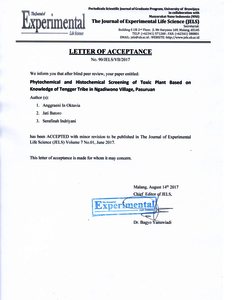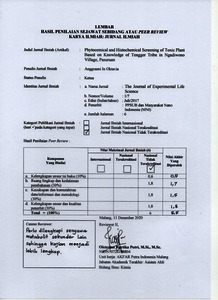Oktavia, Anggraeni In, Batoro, Jati and Indriyani, Serafinah (2017) Phytochemical and Histochemical Screening of Toxic Plant Based on Knowledge of Tengger Tribe in Ngadiwono Village, Pasuruan. [Experiment]
|
Text
10. Anggraeni In Oktavia - JELS vol 7 no.1 2017.pdf - Published Version Download (1MB) |
||
|
Text
originality report 18.8.2017 9-58-6 - JELS - 070113.pdf - Published Version Download (264kB) |
||
|
Text
Borang Penilaian Artikel JELS - Oktavia et al.pdf Download (672kB) |
||
|
Text
peer reviw jurnal imiah001.pdf Download (57kB) |
||
|
Text
JELS - 070113.doc Download (374kB) |
||
![[img]](https://repository.poltekkespim.ac.id/472/9.hassmallThumbnailVersion/LOA%20JELS.jpg)
|
Image
LOA JELS.jpg Download (148kB) | Preview |
|
|
Text
Peer-Review II Jurnal_Anggraeni In Oktavia.pdf Download (31kB) |
||
![[img]](https://repository.poltekkespim.ac.id/472/15.hassmallThumbnailVersion/Peer-Review%20III%20Jurnal_Anggraeni%20In%20Oktavia.jpeg)
|
Image
Peer-Review III Jurnal_Anggraeni In Oktavia.jpeg Download (290kB) | Preview |
Abstract
Around hundreds of plant’s species have been confirmed to produce toxic that could endanger the life of human or domestic animals. Some of those plants have potentials to be developed as medicine. The objective of this study is to reveal the secondary metabolite content of toxic plants mentioned by Tengger tribe on Ngadiwono village through phytochemical and histochemical screening test. This study was conducted on Ngadiwono village, Tosari district, Pasuruan Regency. Informants were selected using snowball method by following the information of key person (n informant=14). Plants were selected and collected according to the local knowledge, then was analyzed qualitatively for its secondary metabolite content through phytochemical and histochemical screening test. The results showed that there are 8 plant species categorized as toxic by local people, including Bedor (Girardinia palmata), Kecubung Bunga Kuning (Brugmansia suaveolens), Kecubung Bunga Putih (Brugmansia suaveolens), Jarak (Ricinus communis), Terpasan Kuning (Cestrum elegans), Terpasan Merah (Cestrum elegans), Kudisan (Euphorbia pulcerrima), and Ciplukan (Physalis peruviana). The phytochemical result indicated that all toxic plants mentioned by the local people contain alkaloid substancess, while histochemical test showed that alkaloid substances were found in leaf trichomes, except in Terpasan Merah (Cestrum elegans). Keywords: Fitochemical, Histochemical, Tengger Tribe, Toxic Plant
| Item Type: | Experiment |
|---|---|
| Subjects: | C ILMU > CB Kimia |
| Divisions: | D3 FARMASI |
| Depositing User: | Sugeng Setiawan |
| Date Deposited: | 13 May 2020 03:56 |
| Last Modified: | 11 Dec 2020 04:39 |
| URI: | http://repository.poltekkespim.ac.id/id/eprint/472 |
Actions (login required)
 |
View Item |


